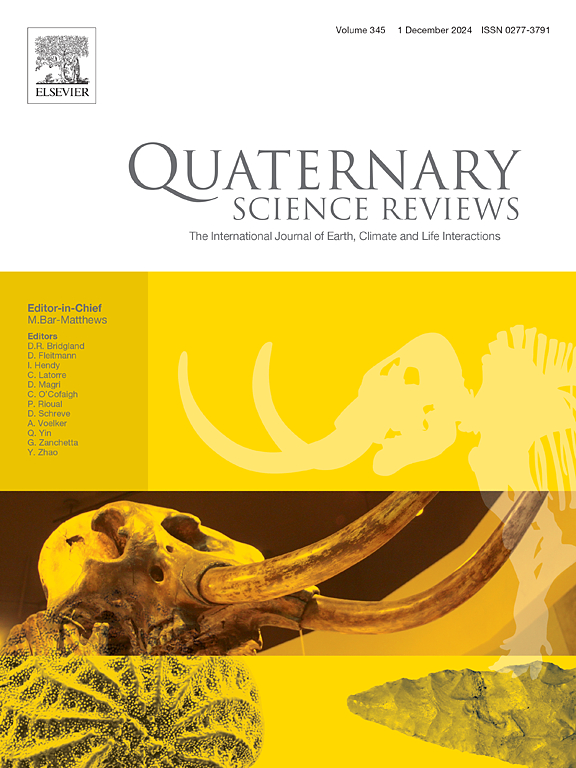Quaternary sedimentary evolution and source apportionment in the northwestern South China Sea: Evidence from geochemical and zircon U-Pb data
IF 3.3
1区 地球科学
Q1 GEOGRAPHY, PHYSICAL
引用次数: 0
Abstract
The sedimentary basins in the northwestern South China Sea (SCS) preserve crucial records regarding the evolution of the Qinghai-Tibet Plateau and exhibit significant potential as hosts for natural gas hydrate resources. However, the limited availability of Quaternary stratigraphic samples in this region has impeded a more comprehensive understanding of the Quaternary sedimentary evolution within the area. This study integrates new and published detrital zircon U-Pb ages with geochemical analyses to elucidate the provenance and transport pathways of Quaternary sediments in the Qiongdongan Basin (QDNB) in the northwestern SCS, providing new insights into its evolution. Analyses of major and trace elements in Quaternary sediments, along with detrital zircon U-Pb age spectra, indicate that the QDNB primarily received sediment supply from the Red River source, with significant characteristics of the Pearl River source also observed in the eastern and northeastern parts of the basin. The contribution from Hainan Island was limited, even in the northern shelf areas closer to the island. Quantitative analysis reveals a gradual increase in the contribution of the Pearl River source from the western to the eastern deep-water regions of the QDNB, ranging from 46.05 % to 65.74 %. It is inferred that deep currents transport fine-grained sediments, predominantly from the Pearl River source, from the eastern side of the Xisha Trough to the QDNB. However, within the QDNB, the Quaternary sediments are primarily influenced by the Red River source. Topography is the primary factor controlling the large-scale migration of sediments in the northwestern SCS, while ocean currents have a significant impact on the transport of fine-grained sediments. The rapid uplift of the Qinghai-Tibet Plateau during the Quaternary was a primary driver of accelerated sedimentation rates in the northwestern SCS basin. This study elucidates the spatial variations in sediment provenance across different regions of the northwestern SCS, providing crucial geological evidence for understanding the Quaternary sedimentary evolution.
南海西北部第四纪沉积演化与物源划分:来自地球化学和锆石U-Pb数据的证据
南海西北部沉积盆地保存了青藏高原演化的重要记录,显示出巨大的天然气水合物储集潜力。然而,该地区第四纪地层样品有限,阻碍了对该地区第四纪沉积演化的更全面认识。本研究将最新和已发表的碎屑锆石U-Pb年龄与地球化学分析相结合,阐明了南海西北部琼东安盆地第四纪沉积物的物源和搬运途径,为其演化提供了新的认识。第四纪沉积物主微量元素分析及碎屑锆石U-Pb年龄谱表明,秦岭东缘沉积物主要由红河源区供给,盆地东部和东北部也具有明显的珠江源区特征。海南岛的贡献是有限的,即使在靠近海南岛的北部大陆架地区也是如此。定量分析表明,珠江源区的贡献从西部向东部深水区逐渐增加,从46.05%到65.74%不等。推断深流主要将细粒沉积物从西沙海槽东侧输送至秦岭海槽。第四纪沉积主要受红河源区的影响。地形是控制南海西北部沉积物大规模迁移的主要因素,而洋流对细粒沉积物的迁移有重要影响。第四纪青藏高原的快速隆升是南海西北部盆地沉积速率加快的主要驱动因素。本研究阐明了南海西北部不同区域沉积物物源的空间差异,为了解第四纪沉积演化提供了重要的地质证据。
本文章由计算机程序翻译,如有差异,请以英文原文为准。
求助全文
约1分钟内获得全文
求助全文
来源期刊

Quaternary Science Reviews
地学-地球科学综合
CiteScore
7.50
自引率
15.00%
发文量
388
审稿时长
3 months
期刊介绍:
Quaternary Science Reviews caters for all aspects of Quaternary science, and includes, for example, geology, geomorphology, geography, archaeology, soil science, palaeobotany, palaeontology, palaeoclimatology and the full range of applicable dating methods. The dividing line between what constitutes the review paper and one which contains new original data is not easy to establish, so QSR also publishes papers with new data especially if these perform a review function. All the Quaternary sciences are changing rapidly and subject to re-evaluation as the pace of discovery quickens; thus the diverse but comprehensive role of Quaternary Science Reviews keeps readers abreast of the wider issues relating to new developments in the field.
 求助内容:
求助内容: 应助结果提醒方式:
应助结果提醒方式:


